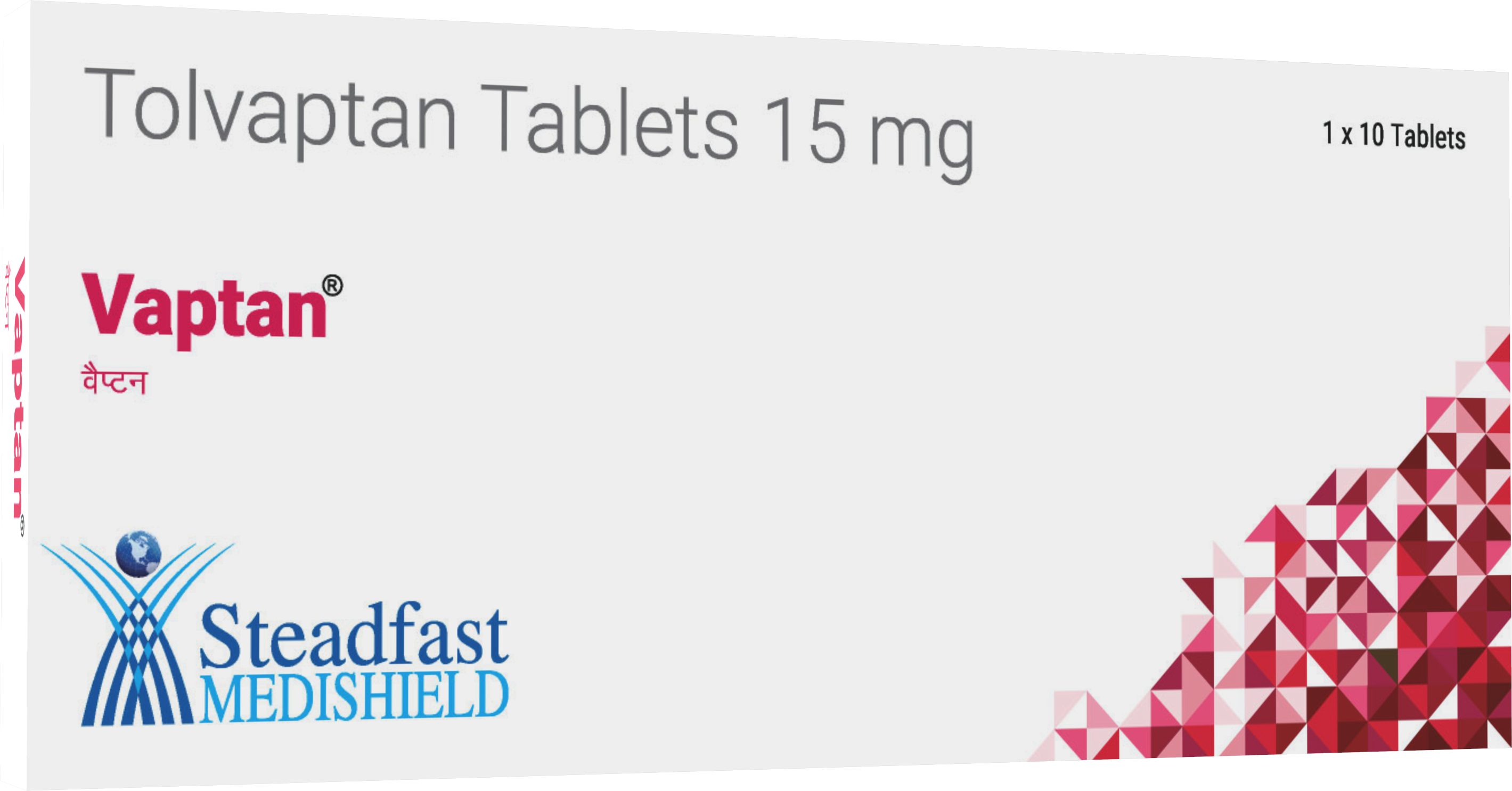
Description:
Tolvaptan is a small, synthetic molecule with an emperical formula and a molecular weight of 448.94.
Tolvaptan belongs to to a new class of medication called “Vaptan” drugs which blocks the action of Vasopressin receptors. Selective vasopressin V2-receptor antagonist.
Composition:
Vaptan is composed of Tolvaptan 15mg tablet. The tablet is a score tablet.
Introduction:
Tolvaptan is the first drug specifically for the treatment of Autosomal Dominant Polycystic Kidney Disease (ADPKD). Tolvaptan is a new medication that affects how the kidneys control the concentration of urine.
Taking Tolvaptan will cause to produce a larger amount of more diluted urine.
Tolvaptan has been shown to slow down the growth of kidney cysts in some people with ADPKD.
Tolvaptan helps to protect the function of kidneys and delays the need for a kidney transplant or dialysis. Kidney function would continue to decline, but at a slower rate.
Indications & clinical use:
Tolvaptan is indicated to delay the progression of kidney enlargement in patients with ADPKD. In ADPKD, kidney enlargement reflects renal cyst burden.
Indicated for adults with clinically significant Euvolemic or Hypervolemic Hyponatremia (serum sodium <125 mEq/L or less marked Hyponatremia that is symptomatic and has resisted correction with fluid restriction), including patients with heart failure, cirrhosis & SIADH.
Mechanism of Action:
Vaptan (Tolvaptan) is a selective vasopressin V2-receptor antagonist with an affinity for the V2-receptor that is 1.8 times that of native arginine vasopressin (AVP). When taken orally, Tolvaptan inhibits the binding of Vasopressin at the V2 receptor in the kidney. The decreased binding of Vasopressin to the V2 receptor lowers adenylate cyclase activity resulting in a decrease in intracellular adenosine 3’, 5’-cyclic monophosphate (cAMP) concentrations.
Dosage & Administration: ADPKD (As advised by Physician)
Vaptan treatment should be initiated and monitored by a physician experienced in the diagnosis and treatment of polycystic kidney disease.
Vaptan should be administered twice daily in split Tolvaptan dose regimens of:
45+15 mg 60+30 mg 90+30 mg
According to the split dose regimen, the total daily Tolvaptan doses are 60, 90 and 120mg respectively. Prior to initiating therapy, restrict overnight fluid intake for 10 to 14 hours to assess ability to concentrate urine using urine osmolality or specific gravity.
However, as per the international trials the recommended doses are between 60 – 120 mg but recent studies suggest to initiate at 15mg (morning) plus 15mg (evening) or
30 mg (morning) plus 15 mg (evening) to avoid discontinuation and tolerable titration.
Titrate every 1-4 weeks to 90mg (morning) plus 30mg (evening) daily or maximum tolerated dose.
Dosage & Administration: Hyponatremia (As advised by Physician)
Initial:
15mg PO q Day
Maintenance: May increase to 30 mg qday after at least 24 hr to achieve the optimal serum sodium level, not to exceed 60mg/day
Not to exceed 30 days of treatment.
Pharmacodynamics/Kinetics:
Onset of Action- 2 to 4 hours
Peak effect- 4 to 8 hours
Duration- 60% peak serum sodium elevation is retained at 24 hours; urinary excretion of free water is no longer elevated.
Distribution- Vd: 3L/Kg
Protein Binding- 99%
Metabolism- Hepatic via CYP3A4
Bioavailability- ~40%
Half Life elimination- ~12 hours; dominant half life <12 hours
Time to peak, plasma- 2 to 4 hours
Excretion- Faeces (19% as unchanged drug)
Contraindications:
Hypovolemia
Hypernatremia
Patients who cannot perceive or respond to thirst
Patients with clinically relevant impairment of hepatic function (see WARNINGS AND PRECAUTIONS, Hepatotoxicity, and/or Hepatic Impairment, and DOSAGE AND ADMINISTRATION, Dosing Considerations, Hepatic Impairment)
Anuric patients (see WARNINGS AND PRECAUTIONS, Renal Impairment) Pregnancy, nursing mothers
Patients who are hypersensitive to this drug or to any ingredient in the formulation.
Precautions:
Do not use for ADPKD outside of FDA- approved risk evaluation and Mitigation Strategy (REMS); risk of serious and potentially fatal liver injury.
Avoid in patients with underlying liver disease, including cirrhosis, discontinue if symptoms of liver injury develop. Severe renal impairment (Crcl<10ml/min): not recommended.
Nursing mothers: not recommended
Storage & Stability:
Store at 15degree C to 30 degree C, room temperature Store in a dry place.
Keep all drugs out of reach of children and pets.
Drug Interactions:
Tolvaptan is a substrate of CYP3A, and thus co-administration with CYP3A inhibitors or CYP3A inducers may lead to a change in Tolvaptan exposure. Patient response should be monitored and the dose adjusted accordingly. Tolvaptan does not inhibit or induce its own metabolism.
Non-clinical studies indicate that Tolvaptan is a substrate and competitive inhibitor of p-glycoprotein; other transporters have not been studied.
There have been no trials performed to determine the potential interaction of tolvaptan with alcohol.
Drug-Drug Interactions
Effects of Other Drugs on Tolvaptan
CYP3A Inhibitors
Co-administration of a 30 mg single dose of tolvaptan with 200 mg QD ketoconazole resulted in a 440% increase in AUC and 248% increase in Cmax for tolvaptan (see WARNINGS AND PRECAUTIONS, CYP3A Inhibitors).
CYP3A Inducers
Co-administration of a single oral dose of 240 mg of tolvaptan with 600 mg QD of rifampicin, a strong CYP3A4 inducer, at steady state decreased tolvaptan Cmax and AUCt by approximately 85% (see WARNINGS AND PRECAUTIONS, CYP3A Inducers).
P-gp Inhibitors
Co-administration of tolvaptan with P-gp inhibitors has not been studied in dedicated clinical studies (see WARNINGS AND PRECAUTIONS, P-gp Inhibitors).
Effects of Tolvaptan on Other Drugs
CYP3A substrates
In healthy subjects, tolvaptan, a CYP3A substrate, had no effect on the plasma concentrations of some other CYP3A substrates, e.g., warfarin or amiodarone. However, tolvaptan increased plasma levels of lovastatin by 1.3- to 1.4-fold, indicating a potential effect on weak substrates of CYP3A substrates.
Digoxin
Steady-state digoxin concentrations were statistically significantly increased (approximately 30% increase as determined by Cmax and 20% increase as determined by AUCτ), when digoxin was co-administered with multiple 60 mg doses (QD) of Tolvaptan; in vitro studies indicate that Tolvaptan
is a substrate and competitive inhibitor of p-glycoprotein. Patients receiving digoxin should be evaluated for excessive digoxin effects after adding Tolvaptan.
Warfarin, Amiodarone, Furosemide, and Hydrochlorothiazide
Co-administration of Tolvaptan does not appear to alter the pharmacokinetics of warfarin, furosemide, hydrochlorothiazide, or amiodarone (or its active metabolite, desethylamiodarone) to a clinically significant degree.
Vasopressin Analogues
In addition to its renal aquaretic effect, Tolvaptan is capable of blocking vascular vasopressin V2 receptors involved in the release of coagulation factors (e.g., von Willebrand’s factor) from endothelial cells. Therefore, the effect of vasopressin analogs such as desmopressin may be attenuated in patients using such analogs to prevent or control bleeding when co-administered with Tolvaptan.
Drug-Food Interactions
Grapefruit Juice
Co-administration of Tolvaptan with 240 mL of grapefruit juice produced a doubling of peak Tolvaptan concentrations (Cmax) but had no effect on Tolvaptan elimination half-life
Drug-Herb Interactions
Interactions with herbal products have not been established; however, St John’s Wort should be avoided while taking Vaptan.
Pharmacodynamic Interactions
Concomitant Diuretic Use
Tolvaptan use alone produces a greater 24-hour urine volume than does furosemide or hydrochlorothiazide alone. However, concomitant administration of Tolvaptan with furosemide or hydrochlorothiazide results in a 24-hour volume that is similar to that after Tolvaptan administration alone.
Furosemide co-administered with Tolvaptan produces a similar maximal rate of urine excretion compared to furosemide alone, and 70% higher than Tolvaptan alone. HCTZ co-administered with Tolvaptan produces a slightly higher maximal excretion rate compared to Tolvaptan alone, and 66% higher compared to HCTZ alone.
Patients to be considered for treatment with Vaptan in ADPKD
Patients aged 18-55 yrs
In Mayo class 1C, 1D or 1E
With eGFR >25ml/min per 1.73m2 should be considered for treatment with Tolvaptan.
Storage:
Keep in a dry place at a temperature not exceeding 30°C. Protected from light.
Presentation:
10 tablets packed in a strip, 1 such strip packed in a mono carton
